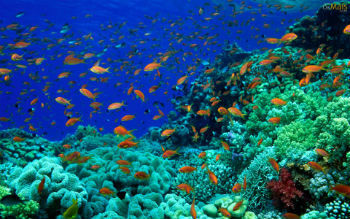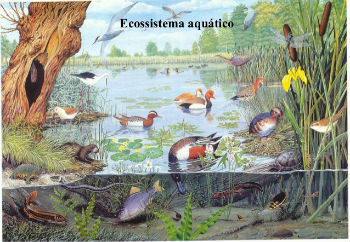Aquatic ecosystems comprise water environments. They range from a small body of water to the oceans.
As occurs in terrestrial ecosystems, aquatic ecosystems also present different types of ecological relationships and interactions between biotic and abiotic factors.
Types
Aquatic ecosystems are classified according to the characteristics of: temperature, salinity, water movement, depth and incidence of sunlight.
Discover the two main types of aquatic ecosystems:
marine ecosystem

Marine ecosystems include the seas and oceans, which cover approximately 71% of the Earth's surface.
They can be classified according to water depth as follows:
- coastal zone: region between the tidal limits, being exposed periodically.
- neritic zone: region of the sea on the continental shelf that extends up to 200 m deep, being illuminated by sunlight.
- oceanic zone: region between 200 to 2000 m deep, there is no sunlight illumination and animals become scarcer.
- benthic zone: corresponds to the seabed inhabited by some species.
The seas and oceans are also classified according to the zones that receive or not the sun's rays:
- photic zone: region that receives sufficient sunlight for the photosynthesis of aquatic producing beings.
- aphotic zone: region without incidence of sunlight and inhabited only by heterotrophic beings.
Read about the Seas and Oceans of the World.
freshwater ecosystem

Freshwater ecosystems encompass streams, lakes, ponds, glaciers, underground reservoirs and rivers.
They are to be classified into the following zones:
- Wet or flooded area: areas of soil saturated with water and harboring characteristic vegetation. Examples are swamps and marshes. When associated with the marine environment we have the mangroves.
- Lentic zone: areas of water with little flow or standing still, such as lakes, ponds, puddles and underground reservoirs.
- lotic zone: area with fresh running water such as rivers, streams and streams.
There are still the estuaries found at the mouths of rivers and joining the seas. They have as their main characteristic the mixture of fresh and salt water.
Because they receive nutrients from the river and the sea, estuaries are highly productive aquatic ecosystems.
Learn more about ecosystems:
- ecosystem
- terrestrial ecosystem
- Biotic and abiotic factors
- ecological relationships
- What is Ecology?
aquatic food chain
THE food chain it corresponds to the path of matter and energy that begins with the producing beings and ends with the decomposers.
O phytoplankton it is an important primary producer of aquatic ecosystems, representing the base of the food chain and serving as food for other organisms.

Importance and Threats
Ecosystems represent the basic unit of the study of Ecology. Furthermore, it is in it that all the ecological relationships between species and their interaction with environmental factors are developed.
However, human activities drastically modify aquatic ecosystems. An example is the eutrophication, a process that adds organic matter to aquatic environments as a result of sewage or industrial waste runoff.
This condition alters the functioning of the food chain, causing an imbalance in the ecosystem and contaminating the water.
THE water pollution it is another factor that can lead to the destruction of aquatic ecosystems and the disappearance of species.
Read too:
- Biosphere
- Brazilian ecosystems
- Brazilian Biomes
Also find out about the Brazilian biomes:
See too: Food Chain Exercises

